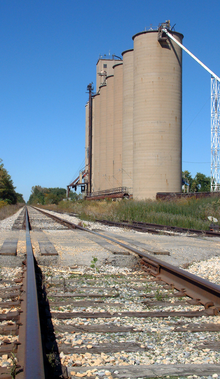Grain trade
The grain trade refers to the local and international
The grain trade is as old as agricultural settlement, identified in many of the early cultures that adopted sedentary farming. Major societal changes have been directly connected to the grain trade, such as the fall of the Roman Empire. From the early modern period onward, grain trade has been an important part of colonial expansion and international power dynamics. The geopolitical dominance of countries like Australia, the United States, Canada and the Soviet Union during the 20th century was connected with their status as grain surplus countries.
More recently,
History
This section needs additional citations for verification. (July 2022) |

Classical world
In the ancient world, grain regularly flowed from the
Merchant shipping was important for the carriage of grain in the classical period (and continues to be so). A Roman merchant ship could carry a cargo of grain the length of the Mediterranean for the cost of moving the same amount 15 miles by land. The large cities of the time could not exist without the supplies delivered. For example, in the first three centuries AD, Rome consumed about 150,000 tons of Egyptian grain each year.[5]: 297
During the classical age, the unification of

In Europe, with the fall of the Roman Empire and the rise of feudalism, many farmers were reduced to a subsistence level, producing only enough to fulfill their obligation to their lord and the Church, with little for themselves, and even less for trading. The little that was traded was moved around locally at regular fairs.
Early modern and modern expansion
A massive expansion in the grain trade occurred when Europeans were able to bring millions of square kilometers of new land under cultivation in
During this time, debate over tariffs and free trade in grain was fierce. Poor industrial workers relied on cheap bread for sustenance, but farmers wanted their government to create a higher local price to protect them from cheap foreign imports, resulting in legislation such as Britain's Corn Laws.[6]

As Britain and other European countries industrialized and urbanized, they became net importers of grain from the various

20th century changes

In the 1920s and 1930s, farmers in Australia and Canada reacted against the
At the same time in the

By the second half of the 20th century, the grain trade was divided between a few state-owned and privately owned giants. The state giants were
In 1972, the Soviet Union's wheat crop failed. To prevent shortages in their country, Soviet authorities were able to buy most of the surplus American harvest through private companies without the knowledge of the United States government. This drove up prices across the world, and was dubbed the "
By contrast, in 1980, the US government attempted to use its food power to punish the Soviet Union for its invasion of Afghanistan with an embargo on grain exports. This was seen as a failure in terms of foreign policy (the Soviets made up the deficit on the international market), and negatively impacted American farmers.
Modern trade

Since the Second World War, the trend in North America has been toward further consolidation of already vast farms. Transportation infrastructure has also promoted more economies of scale. Railways have switched from coal to diesel fuel, and introduced hopper car to carry more mass with less effort. The old wooden grain elevators have been replaced by massive concrete inland terminals, and rail transportation has retreated in the face of ever larger trucks.
Price volatility and protections
Price volatility greatly effects countries that are dependent on grain imports, such as certain countries in the

Protection against international market prices has been an important part of how some countries have responded to the volitility of market prices. For example, farmers in the
Similarly, protections in other contexts, such as guaranteed prices for grains in India, have been an important lifeline for small farmers in the context of further industrialization of agriculture. When the BJP Party government of Narendra Modi attempted to repeal guaranteed prices for farmers on key grains like wheat, farmers throughout the country rose in protest.[8][9][10]
See also
References
- )
- ^ a b "Climate Change Is Likely to Devastate the Global Food Supply". Time. Retrieved 2 April 2022.
- ^ "CLIMATE CHANGE LINKED TO GLOBAL RISE IN FOOD PRICES – Climate Change". Archived from the original on 18 October 2022. Retrieved 2 April 2022.
- ISSN 0362-4331. Retrieved 2 April 2022.
- ISBN 0-8018-5130-0.
- ^ One or more of the preceding sentences incorporates text from a publication now in the public domain: Chisholm, Hugh, ed. (1911). "Grain Trade". Encyclopædia Britannica. Vol. 12 (11th ed.). Cambridge University Press. pp. 322–325.
- ^ Food price spikes put the spotlight on the need for sustained commitment to agriculture Archived 10 February 2014 at the Wayback Machine, International Centre for Trade and Sustainable Development, 1 June 2010.
- ^ Singh, Prashasti, ed. (28 September 2020). "Farmers across India protest against farm bills. In photos". Hindustan Times. Archived from the original on 5 October 2020. Retrieved 7 October 2020.
- ^ "PM Modi reaches out to farmers amid anger". Hindustan Times. 28 September 2020. Archived from the original on 8 October 2020. Retrieved 7 October 2020.
- ^ Mathur, Swati (28 September 2020). "Farm bills 2020: President Kovind gives assent to controversial farm bills, laws come into force immediately". The Times of India. Archived from the original on 3 October 2020. Retrieved 7 October 2020.
Works cited
- W. Broehl, Cargill Going Global, University of New England Press, 1998.
- W. Broehl, Cargill Trading the World's Grain, University of New England Press, 1992.
- Chad J. Mitcham, China's Economic Relations with the West and Japan, 1949-79: Grain, Trade and Diplomacy, Routledge, 2005.
- Dan Morgan, Merchants of Grain, Viking, 1997.
- W.E. Morriss, Chosen Instrument: A History of the Canadian Wheat Board, the McIvor Years, Canadian Wheat Board, 1987

